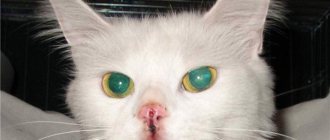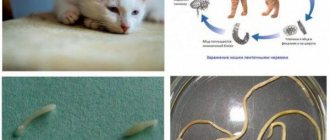Author: Olga Sergeevna Shiltsova, practicing veterinarian, diploma from St. Petersburg State Academy of Veterinary Medicine in 2011
The condition of the skin and coat is the main indicator of the health of our pets. Long before other signs of disease appear, owners notice the appearance of dandruff, dull fur or scratching. If we talk about skin damage, cats suffer from them much more often than dogs - due to their own sharp claws and rough horny tongue. Scratching on the skin is a clear sign of itching in a cat, even if the pet does not itch in front of its owners and tries to maintain a calm appearance.
Inflammation of the skin, areas of baldness, itching are reasons to consult a veterinary dermatologist. The doctor will identify the cause and prescribe medications for scratching in the cat based on the diagnosis.
The procedure for making a diagnosis for skin problems in a cat
The veterinarian begins the appointment from afar - asks the owner about the conditions of the pet’s keeping, about nutrition, about changes in behavior. Only after this the specialist examines the animal. First, the doctor assesses the general condition of the skin and coat and pays attention to the location of the problem. So, scratching near the ears of a cat may indicate that the problem lies inside the ear. Severe itching is caused by otodectosis - ear scabies.
If lichen is suspected, Wood's lamp diagnostics is used. The skin and fur are examined under ultraviolet light in a completely dark room. Some fungal colonies will glow bright green. Even if there is no glow, a dermatologist can take a culture for the fungus.
Deep skin scrapings and microscopy are needed to detect subcutaneous microscopic mites in sarcoptic mange. But again, a negative scraping is not a sufficient basis to exclude the diagnosis.
In general, diagnosis in dermatology is complicated precisely because most diagnoses are confirmed empirically - the response to therapy is assessed. Some external parasites can be seen upon careful examination - haietiella, lice-eaters, fleas. But most often it is not possible to detect fleas. 90% of the flea population does not live on an animal, but is found in the environment. Those fleas that are on a cat cleverly hide in the thick undercoat and are often swallowed by licking and biting.
The dermatologist usually tells you how to treat your cat's scratching, and then begins to rule out the causes of itching one by one, starting with the most obvious ones. And the first recommendation is always treatment for fleas and other external parasites for at least three months.
Infestation by exogenous insects
Both fleas and other bloodsuckers can parasitize a cat’s body . The presence of these insects leads to the occurrence of various diseases. The most dangerous of them include:
- flea dermatitis;
- mite damage: sarcoptic mange, notoedrosis.
When a flea bites, a wound with their saliva remains on the animal's body, causing severe itching. The cat begins to vigorously scratch the affected area, which leads to the infection getting inside. The inflammatory process in combed areas is manifested by redness and hair loss.
Fleas not only contribute to the occurrence of infectious diseases, but are also carriers of worm eggs (helminths).
When infected with ticks, the clinical picture in cats is as follows::
- severe itching on dry areas of the skin;
- hair loss;
- formation of ulcers on exposed areas.
Notoedrosis in cats is manifested by the presence of Notoedres cat mites and is accompanied by the following symptoms:
- itching and severe scratching;
- rash in the form of blisters;
- the appearance of crusts on itchy areas;
- hair loss;
- loss of skin elasticity, appearance of cracks infected with bacteria and fungi.
Sarcoptic mange occurs in cats due to their infestation with mites of the species Sarcoptes canis .
These tiny bloodsuckers are 0.2-0.4 mm long and have a long proboscis. Thanks to this, they easily gnaw holes in the skin and make a large number of moves in it. Once on the animal's body, the parasites begin to actively lay larvae. In this regard, already 1.5 months after their appearance, their numerous offspring are present on the cat’s body. The main symptom of this disease is severe itching, which gets worse in the evening. First of all, the tick infects areas on the animal’s head, neck, and near the ears, where blisters and redness immediately appear. After a while, these places become covered with dried crusts. The animal becomes restless, constantly itches and meows. Constantly scratching itchy areas, the cat cannot sleep, loses its appetite and experiences weight loss.
Therapy involves not only getting rid of bloodsuckers, but also healing damaged skin areas, as well as restoring the pet’s immune system.
Important! At the first signs of sarcoptic mange, the cat should be shown to a specialist.
Scratch treatment
First of all, you need to remove the cause of itchy skin. Any veterinarian will tell you how to treat cats scratching on the neck and other areas of the body: you have to start with antiparasitic treatment. You should use modern means - they are effective and safe. You should not wash cats if you suspect a flea infestation - this is very stressful for cats, and bathing will not help get rid of parasites. If you wash off the natural fat layer from the skin, this will prevent the drops from being absorbed onto the withers, and it is the drops that most veterinarians prescribe for the treatment of parasitosis. It is painless for the cat and convenient for the owners.
Alcohol-based drops, such as Stronghold, are absorbed and evaporated very quickly - after just two hours you can stroke your cat’s fur. This is especially important if there are children in the house. "Stronghold" is convenient and has a wide weight range. If it is not possible to weigh your pet at a veterinary clinic, drops for cats weighing 2.6-7.5 kg are suitable for most adult animals.
After regular treatment with flea and tick drops, you can move on to further diagnostics, such as an elimination diet to detect food allergies.
Sometimes it takes a long time to conduct research and eliminate the problem, and you need to stop the painful process of itching as early as possible. Then antipruritic therapy is used.
Often owners are interested in what to anoint their cat’s scratches to speed up their healing. The choice of ointment depends on whether a secondary bacterial infection has developed after skin damage. You can use complex ointments with antipruritic, antifungal and antibacterial effects. But if the cat has scratches on its back, you will have to put a collar on the pet to prevent licking of the drug.
Omega-3 fatty acids, B vitamins (brewer's yeast) and trace elements such as sulfur and zinc contribute to skin healing. Fish oil, brewer's yeast or special vitamin-mineral complexes for skin and coat are added to the diet of natural-fed cats. If your cat eats commercial food, then it is enough to switch to a special diet to treat dermatitis.
Infectious skin diseases
Skin diseases are the most common problems causing problems for cats and their owners.
Most often, this affects pets that occasionally walk outside. Diseases caused by bacterial infections occur in two forms , such as:
- dry, accompanied by the formation of dry scaly plates and crusts;
- wet, expressed in the appearance of ulcers and blisters filled with exudate.
Cats that have suffered serious illnesses, as well as surgical operations, remain immobile for some time, as a result of which they develop bedsores. Tissue necrosis occurs in areas of prolonged contact of the skin with the litter. To prevent this, the animal must be turned over as often as possible, and places where bedsores may form should be wiped with camphor alcohol or disinfectants.
Cats with hypersensitive skin are at risk of developing eczema . The reasons for its occurrence may be different:
- skin damage due to prolonged friction from contact with any object (collars, harnesses, etc.), due to burns and parasite bites;
- consequences of internal disorders in the body (neuropathy): hormonal imbalance, diabetes.
With eczema, the animal's skin develops rashes and blisters . There is a constant itching sensation in the affected areas (including the neck). To treat this disease, various ointments, soothing powders, and antibiotics are used.
A common disease among cats is acne (blackheads). Its cause may be the animal's low immunity, being under stress or improper care. This bacterial infection has a detrimental effect on the sebaceous glands. As a rule, its presence is indicated by rashes in the form of ulcers throughout the animal’s body. The largest accumulation of acne occurs on the cat's chin, neck and lip area.
At the beginning of treatment, the skin is first treated with antiseptic detergents.
Preventing skin problems in cats
Regular treatment for external and internal parasites is a prerequisite for the prevention of diseases in cats. In the warm season, it is especially important to protect your pet from fleas and ticks, and in some cases (warm climate, contact with stray animals, etc.) treatment should be year-round. You need to use safe products to which the cat is not allergic, and weigh the animals before treatment.
Healthy, well-groomed pets rarely become infected with fungal infections. Therefore, conditions of detention are important. In addition to protection from external parasites, the cat should regularly receive anthelmintic, be vaccinated in a timely manner, and for older animals an annual medical examination with blood tests is also relevant.
Balanced, nutritious feeding also helps maintain healthy skin and coat, regardless of whether you prefer natural food or commercial food. A healthy cat should have a “glossy” appearance and not suffer from year-round shedding, mats or dandruff.
Some diseases, such as autoimmune diseases or allergic reactions, cannot be predicted or prevented. In this case, the owner can do only one thing - promptly contact a specialist if the cat develops scratching or other skin problems.
^ Top ^
Itching caused by helminths
There are a large number of varieties of parasitic worms that take up residence in a cat’s body. They can be:
- round;
- flat;
- tape.
Usually at the very beginning of infection it is difficult to consider any of its symptoms, but after a while the animal:
- loses appetite and activity;
- becomes restless;
- Constantly licks and itches.
Worms found in the intestines are considered almost harmless.
Difficulties with your pet’s health arise when there are too many helminths and their larvae begin to migrate.
The movement of worms throughout the animal’s body is accompanied by the following symptoms:
- sudden weight loss, increased fatigue, growth retardation in small pets;
- disheveled wool;
- enlarged liver and icteric staining of visible mucous membranes;
- disruption of the digestive system, expressed in constipation, vomiting, diarrhea;
- appearance of cough;
- discharge from the eyes;
- itching in the anus;
- presence of blood in feces;
- premature birth or miscarriage in cats;
- convulsions and paresis of the limbs.
The cat may not notice the presence of parasites in the body in small quantities. However, their increase will not only exhaust the animal, but will also lead to its death. The harm caused to pets by worms can be completely different :
- eating lymph, tissue and blood;
- release of substances that promote intoxication;
- damage to the mucous membranes by suction cups, leading to internal bleeding.
After the worms die, decomposition products are formed that poison the animal’s body.
The appearance of parasites leads to metabolic disorders, as a result of which the cat’s skin becomes dry and dandruff appears on it. Just like an allergic reaction, these factors are accompanied by itching, which causes the animal to scratch its neck until it bleeds. A pet can become infected with helminths in the following ways :
- eating raw meat or fish (especially river fish);
- flea bites;
- contacts with other animals.
To prevent itching, which causes painful scratching, animal owners need to regularly take a preventive course using anthelmintic medications.
Parasites
Another cause of itchy skin and scabies can be parasites; scabies mites (sarcoptic mange) are more common in pets. In this case, damage can be found on the cat's elbows, ankles, and ears.
However, only a doctor can make a more accurate diagnosis. To do this, he will make several deep scrapings and, if parasites are found, he will prescribe appropriate treatment.
Itching scabies
This is a tick that parasitizes the head and neck of an animal. The result is damage to the inner layer of skin. Scabies itch feeds on lymph and particles of the inner layer of the epidermis. The parasite lays eggs there.
Symptoms:
- The appearance of red bumps on the skin.
- The appearance of thick crusts on the affected areas.
- Transformation of crusts into papules filled with liquid.
- Thinning of hair in affected areas.
Ear mite
It is a parasite that causes ear scabies (otodectosis) in cats. It settles in the skin folds of the ears and feeds on lymph, skin cells and blood.
Signs of infection:
- Itching in the ears. The cat scratches its ears and shakes its head.
- Redness appears in the folds of the ears.
- The amount of wax in the ears increases.
- A brown coating with an unpleasant odor appears in the ears.
Ixodid tick
This is the most dangerous parasite, a carrier of bacteria. The tick is quite large and feeds on cows. Upon examination, it resembles a gray grape (if it has drunk blood). If the strike appeared recently and did not have time to drink blood, it looks like a small spider.
Causes diseases such as:
- Infectious anemia.
- Damage to the blood and lymph nodes.
- Damage to the spleen and liver.
Such diseases are difficult to tolerate and take a long time to treat. Therefore, the best option is prevention (collars, sprays, drops).
Fly larvae
Fly larvae often appear in open wounds of cats. The insect lays eggs in the animal's wound, causing a disease called myiasis. The larvae feed on living cells, tissues, and fluids from the body.
Course of the disease:
- Larvae emerge from the eggs, they molt, grow, and actively feed on tissues and cells from the wound.
- The larvae penetrate deep into the skin, bringing the infection deeper and deeper. Connective and muscle tissues are damaged.
- The wounds hurt, itch and fester, the animal becomes restless,
- Scratching wounds leads to bacterial infections.
Allergic reactions
Allergies in pets occur due to an inadequate reaction of the body to substances that enter the body from the environment. This could be dust, pollen, one or more components in food, etc. The disease is usually accompanied by:
- severe itching (especially in the head and neck area);
- increased body temperature;
- hyperemia and hair loss.
Long-term exposure to an allergen leads to the development of asthmatic syndrome, atopic dermatitis and the formation of granulomas containing a large number of eosinophilic leukocytes.
An animal with similar symptoms should be shown to a specialist for the purpose of diagnosis and treatment for itching.
If a cat begins to actively scratch its neck, the owner needs to find out the cause of such discomfort as quickly as possible. Serious skin lesions should warrant a visit to the veterinarian. In most cases, skin diseases in cats do not pose a serious threat to their lives , and their treatment can be done at home.











